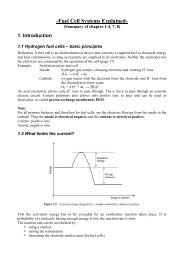Chapter 8. ORGANIC SOLAR CELLS - from and for SET students
Chapter 8. ORGANIC SOLAR CELLS - from and for SET students
Chapter 8. ORGANIC SOLAR CELLS - from and for SET students
Create successful ePaper yourself
Turn your PDF publications into a flip-book with our unique Google optimized e-Paper software.
<strong>SOLAR</strong> <strong>CELLS</strong> <strong>Chapter</strong> <strong>8.</strong> Exciton solar cells<br />
to have high charge carrier mobilities allows an increase in film thickness <strong>from</strong> the usual ~100<br />
nm to well above 500 nm, without a loss of current.<br />
The absorption of the active layer in state-of-the-art devices currently spans the<br />
wavelength range <strong>from</strong> the UV up to about ~ 650 nm. In this wavelength range the<br />
monochromatic external quantum efficiency can be as high as 70% under short-circuit<br />
conditions, implying that the vast majority of absorbed photons contribute to the current. The<br />
intensity of the solar spectrum, however, maximizes at ~700 nm <strong>and</strong> extends into the near<br />
infrared. Hence, a gain in efficiency can be expected when using low-b<strong>and</strong> gap polymers. The<br />
preparation of low-b<strong>and</strong> gap, high mobility <strong>and</strong> soluble low-b<strong>and</strong> gap polymers is not trivial<br />
<strong>and</strong> requires judicious design in order to maintain the open-circuit voltage or efficiency of<br />
charge separation. Because the open-circuit voltage of bulk-heterojunction solar cells is<br />
governed by the HOMO of the donor <strong>and</strong> the LUMO levels of the acceptor, the most<br />
promising strategy seems to lower the b<strong>and</strong> gap by adjusting the other two levels, i.e. decrease<br />
the LUMO of the donor, or increase the HOMO of the acceptor, or both.<br />
Literature used:<br />
1. Halls, J.J. <strong>and</strong> R.H. Friend, Organic Photovoltaic devices, in Clean electricity <strong>from</strong><br />
photovoltaics, M.D. Archer <strong>and</strong> R. Hill, Editors. 2001, Imperial College Press: London.<br />
2. Simon, J. <strong>and</strong> J.J. Andre, Molecular semiconductors. 1985, Berlin-Heidelberg: Springer-<br />
Verlag. 142.<br />
3. Hoppe, H. <strong>and</strong> N.S. Sariciftci, Organic solar cells: An overview. Journal Of Materials<br />
Research, 2004. 19(7): p. 1924-1945.<br />
4. Gregg, B.A., Excitonic solar cells. Journal of Physical Chemistry B, 2003. 107(20): p.<br />
4688-469<strong>8.</strong><br />
5. Gregg, B.A., The photoconversion mechanism of excitonic solar cells. Mrs Bulletin,<br />
2005. 30(1): p. 20-22.<br />
-<strong>8.</strong>16-






